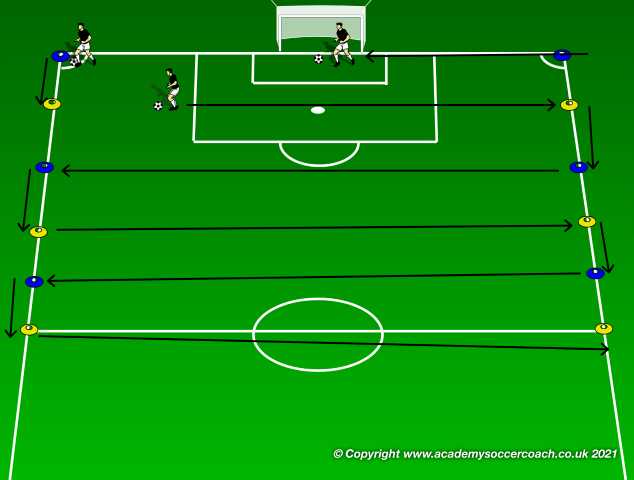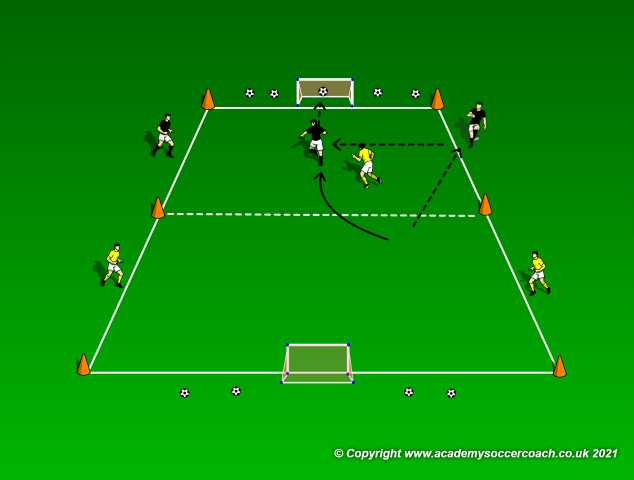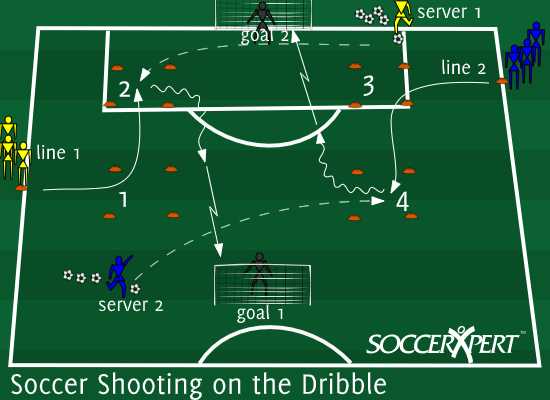Best soccer fitness drills with ball

When it comes to soccer, fitness is key. Being in top physical shape can give players a competitive edge on the field, allowing them to outlast their opponents and maintain peak performance throughout the game. One of the best ways to improve soccer-specific fitness is by incorporating drills that involve the use of a ball.
These soccer fitness drills with a ball not only help players improve their conditioning, but also enhance their technical skills and game awareness. By combining physical exertion with ball control and decision-making, these drills simulate game-like situations and provide a more realistic training experience.
One popular drill is the “shuttle runs with ball” drill. In this drill, players set up a series of cones or markers in a straight line about 10-20 yards apart. Starting at one end, players dribble the ball to the first marker, perform a quick turn or change of direction, and then sprint with the ball to the next marker. They continue this pattern until they reach the end of the line. This drill not only improves speed and agility, but also challenges players to make quick decisions and change direction while maintaining control of the ball.
The Importance of Soccer Fitness
In the game of soccer, fitness plays a crucial role in a player’s performance. It is not enough to possess skills and technique; a player must also have the necessary physical fitness to compete at a high level. Soccer is a demanding sport that requires strength, endurance, agility, and speed. Without proper fitness, players may struggle to keep up with the pace of the game and may be more prone to injuries.
Physical fitness is important for all positions on the field. Defenders need strength and endurance to engage in physical battles, make tackles, and track back to defend. Midfielders require agility and stamina to cover ground, win balls, and distribute play. Forwards need speed and explosive power to make runs, outpace defenders, and finish chances. Without fitness, players may falter in these key areas and not be able to perform at their best.
Furthermore, soccer fitness goes beyond just the physical aspect. It also plays a role in a player’s mental and tactical abilities. When a player is physically fit, they are more likely to make better decisions on the field, react quickly to changing situations, and maintain focus throughout the match. Fitness also enables players to execute specific game plans and strategies effectively, as they have the physical capacity to carry out the necessary actions.
In conclusion, soccer fitness is highly important in the game. It not only enhances a player’s performance but also reduces the risk of injuries. Physical fitness allows players to excel in their positions, make better decisions on the field, and execute game plans effectively. Therefore, it is crucial for soccer players to prioritize their fitness training alongside improving their technical skills.
The Benefits of Being Fit in Soccer
Being physically fit is essential in soccer as it provides numerous advantages for players on the field. From increased endurance and improved speed to enhanced agility and decreased risk of injuries, fitness plays a crucial role in a player’s performance.
1. Increased Endurance

One of the key benefits of being fit in soccer is improved endurance. Soccer matches can be physically demanding, with players needing to run for long periods of time. Being fit allows players to maintain a high level of performance throughout the game, giving them an edge over less fit opponents.
2. Improved Speed and Agility

Being fit also helps soccer players to improve their speed and agility. Fitness training focuses on developing explosive power and quickness, enabling players to sprint faster and change direction swiftly on the field. This can be advantageous in chasing down opponents, creating scoring opportunities, and defending against attacks.
3. Decreased Risk of Injuries
Physical fitness in soccer is closely linked to a reduced risk of injuries. Regular exercise and conditioning help to strengthen muscles and improve flexibility, making players less prone to strains, sprains, and other common soccer injuries. Fit players are also more likely to recover quickly from minor injuries and return to the game faster.
4. Improved Mental Focus
In addition to the physical benefits, being fit in soccer also has positive effects on a player’s mental focus. Fitness training requires discipline, perseverance, and determination, all of which translate into improved concentration and mental resilience on the field. Fit players are better able to make quick decisions, stay alert during the entire match, and maintain a strong competitive mindset.
5. Enhanced Overall Performance
Ultimately, being fit in soccer leads to enhanced overall performance. With increased endurance, speed, agility, decreased risk of injuries, and improved mental focus, players are able to reach their full potential on the field. They can perform at a higher intensity for longer periods of time, contribute more effectively to their team’s tactics, and increase their chances of success in matches.
In conclusion, the benefits of being fit in soccer are extensive. From physical advantages like increased endurance, improved speed and agility, and decreased risk of injuries to mental benefits such as improved concentration and mental resilience, fitness plays a crucial role in a player’s performance. By maintaining a good level of fitness through regular training and conditioning, soccer players can optimize their abilities and excel on the field.
The Significance of Fitness in Soccer Performance
Fitness plays a crucial role in ensuring optimal performance on the soccer field. A high level of fitness is essential for soccer players to meet the physical demands of the game, which includes constant running, explosive sprints, changes in direction, and various other movements. The overall fitness of a player directly impacts their ability to compete effectively, maintain stamina throughout the entire match, and execute skills with precision.
One key aspect of fitness that is particularly important in soccer is cardiovascular endurance. This refers to the ability of the heart and lungs to efficiently deliver oxygen and nutrients to the muscles during prolonged periods of physical exertion. Soccer players need to have a strong cardiovascular system in order to sustain high levels of intensity throughout the game and recover quickly between bursts of activity. Training methods such as interval running, shuttle runs, and high-intensity interval training are commonly utilized to improve cardiovascular endurance in soccer players.
In addition to cardiovascular endurance, muscular strength and power are also crucial components of fitness in soccer. Having strong and powerful muscles allows players to generate explosive bursts of speed, improve agility, and win physical battles on the field. Strength training exercises such as squats, lunges, and plyometric exercises help develop muscle strength and power, enabling players to perform at their peak. A combination of aerobic conditioning, strength training, and regular practice of soccer-specific skills is necessary to achieve optimal fitness levels and enhance overall performance in soccer.
Essential Ball Handling Drills for Soccer Fitness Training
In order to excel in soccer, it is essential to have strong ball handling skills. These skills not only help players maintain control of the ball but also allow them to make precise passes and accurate shots. To improve ball handling skills, there are several drills that can be incorporated into soccer fitness training.
1. Dribbling through cones: Set up a series of cones in different formations and dribble the ball through them. This drill helps improve agility, footwork, and close ball control.
2. Figure eight dribbling: Create a figure eight pattern on the ground using cones and dribble the ball through the pattern. This drill focuses on coordination, quick changes of direction, and improves dribbling skills.
3. One-on-one dribbling: Set up a small playing area and have two players face off against each other. Each player tries to maintain control of the ball while attempting to steal it from their opponent. This drill develops competitive dribbling skills and improves decision making under pressure.
4. Wall passes: Stand a few feet away from a wall and pass the ball against it. As the ball comes back, control it and repeat the pass. This drill enhances passing accuracy, first touch control, and ball control.
5. Juggling: Spend time juggling the ball using different parts of the body, such as feet, thighs, and head. This drill helps improve balance, coordination, and overall ball control.
By incorporating these essential ball handling drills into soccer fitness training, players can enhance their skills and become more confident with the ball. Consistent practice and repetition of these drills will contribute to improved performance on the field.
Best Dribbling Exercises for Soccer Fitness

Dribbling is an essential skill in soccer that allows players to maneuver the ball past defenders and maintain possession. Incorporating specific dribbling exercises into training sessions can help improve a player’s agility, coordination, and ball control. Here are some of the best dribbling exercises to enhance soccer fitness:
1. Cone Dribbling:
Set up a series of cones in a straight line, with each cone about 3-5 yards apart. Dribble the ball through the cones as quickly and accurately as possible, using both feet. Focus on keeping the ball close to your feet and using quick touches to change direction. This exercise helps improve dribbling speed, control, and the ability to change direction rapidly.
2. Dribble and Turn:
Set up a square or rectangular grid and place cones at each corner. Start at one corner and dribble the ball diagonally to the opposite corner, performing a quick turn around the cone. Continue dribbling to the next corner and repeat the turn. This exercise helps simulate game situations where players need to quickly change direction while maintaining control of the ball.
3. One-on-One Obstacle Course:
Set up a series of cones, poles, or other obstacles in a random formation. Pair up players and have them dribble through the obstacle course, attempting to knock the ball away from their opponent while maintaining control of their own. This exercise improves dribbling under pressure and adds an element of competition.
4. Dribble and Shoot:
Set up a goal or target at one end of the field. Dribble the ball from the starting point to the shooting area while performing various dribbling moves such as feints, step-overs, or cuts. Once in the shooting area, take a shot on goal or attempt to hit the target. This exercise combines dribbling skills with shooting accuracy and helps players improve their technique in both aspects.
5. Small-Sided Game with Dribbling Restrictions:
Divide the players into small teams and play a game with specific dribbling restrictions. For example, players can only dribble with their weaker foot or can only take a certain number of touches before passing the ball. This exercise challenges players to think quickly, make decisions under pressure, and develop their weaker foot dribbling.
- Overall, incorporating these dribbling exercises into training sessions can enhance soccer fitness by improving agility, coordination, and ball control.
- Remember to focus on proper technique and encourage players to challenge themselves by setting goals and tracking their progress.
5 Best soccer fitness drills with ball
Practice Soccer At Home: 100 Individual Soccer Drills and Fitness Exercises to Improve Ball Control, Shooting and Stamina In Your Home and Backyard
£27.99
2 used from £4.45
Features
| Release Date | 2020-04-19T00:00:01Z |
| Edition | Illustrated |
| Language | English |
| Number Of Pages | 120 |
| Publication Date | 2020-04-19T00:00:01Z |
| Format | Illustrated |
Football Master ™ Fitness Speed Training Equipment Exercise Aid Set – Includes 6 X 15 cm Speed Hurdles, 1 x 6 metre Agility ladder with 12 Rungs, Carry bag, 10 marker cones For Kids, Teens Soccer
Features
| Color | Fluorescent Green |
101 Great Youth Soccer Drills: Skills and Drills for Better Fundamental Play (NTC SPORTS/FITNESS)
10 used from £2.71
Features
| Part Number | 9780071444682 |
| Is Adult Product | |
| Release Date | 2005-05-03T00:00:01Z |
| Language | English |
| Number Of Pages | 160 |
| Publication Date | 2005-05-03T00:00:01Z |
The Baffled Parent's Guide to Fix-It Drills for Youth Soccer (NTC SPORTS/FITNESS)
Features
| Part Number | Illustrations |
| Is Adult Product | |
| Release Date | 2009-06-03T00:00:01Z |
| Edition | Illustrated |
| Language | English |
| Number Of Pages | 240 |
| Publication Date | 2009-06-03T00:00:01Z |
| Format | Illustrated |
Speed and Agility Training Set, Football Training Equipment with Agility Ladder, Resistancearachute, 10 Disc Cones, Football Kick Trainer, Skipping Rope and Resistance Bands for Soccer Football Drills
Question and answer:
What are dribbling exercises?
Dribbling exercises are drills or activities designed to improve a player’s ability to control the ball while moving and maneuvering around opponents.
Why are dribbling exercises important?
Dribbling exercises are important because they help players develop better ball control, agility, and confidence when dribbling in game situations.
What are some common dribbling exercises?
Some common dribbling exercises include cone drills, dribbling around obstacles, one-on-one challenges, and dribbling while changing speed and direction.
How often should I do dribbling exercises?
To see improvement, it is recommended to practice dribbling exercises at least a few times a week, ideally incorporating them into regular training sessions.
Can dribbling exercises be done alone?
Yes, many dribbling exercises can be done alone. However, practicing with a partner or in a team setting can also be beneficial for game-like scenarios and added pressure.
Conclusion
In conclusion, dribbling exercises are an essential component of improving one’s basketball skills. By regularly practicing and focusing on dribbling drills, players can enhance their ball control, agility, and coordination. These exercises help to develop a player’s ability to maneuver the ball effectively and make quick, accurate decisions on the court. Whether it’s working on crossovers, between-the-legs dribbles, or hesitation moves, dribbling exercises are vital for players of all levels to master. With dedication and persistence, individuals can significantly improve their dribbling skills and become more confident and efficient players. So, lace up your sneakers and start practicing those dribbling exercises to take your basketball game to the next level.
















